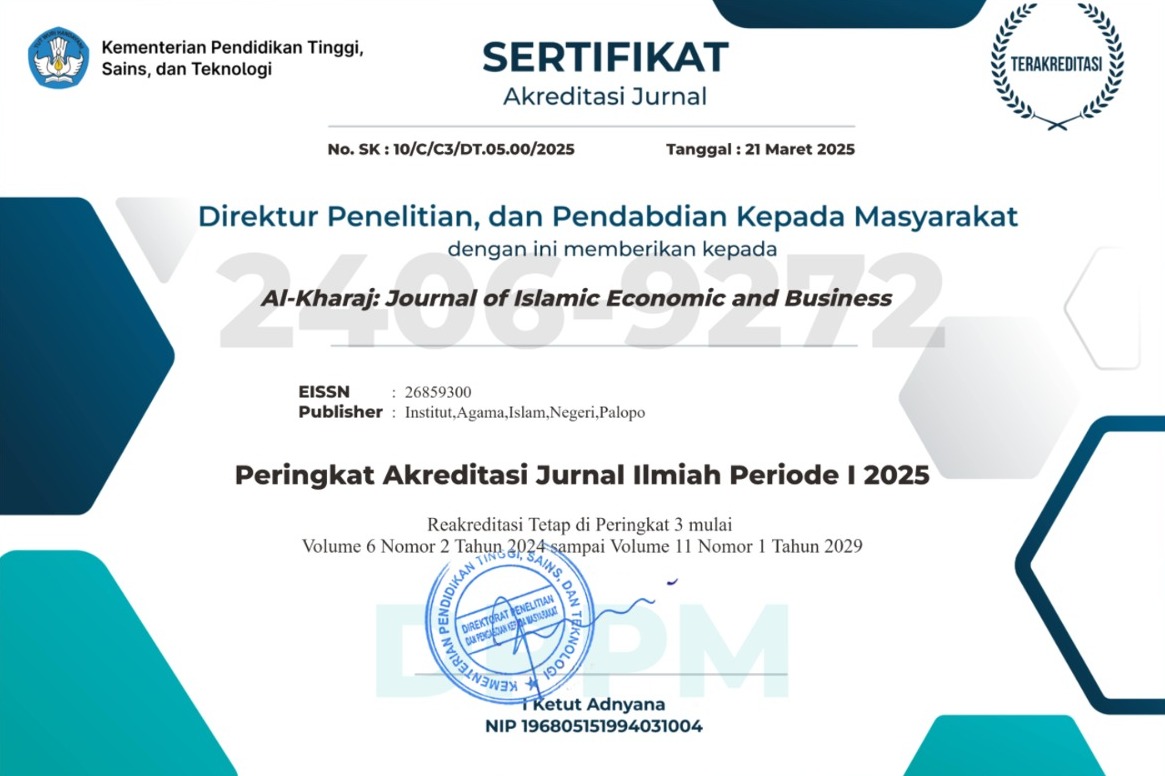ESG and Financial Risk in ASEAN-5: Mediating Role of Financial Constraints
DOI:
https://doi.org/10.24256/kharaj.v7i1.7071Keywords:
ESG Scores, Financial Risk Risk, Financial Constraints.Abstract
References
Adams, C. A. (2017). The Sustainable Development Goals, integrated thinking and the integrated report. Institute of Chartered Accountants of Scotland.
Albuquerque, R., Koskinen, Y., & Zhang, C. (2019). Corporate social responsibility and firm risk: Theory and empirical evidence. Management Science, 65(10), 4451–4469.
Altman, E. I., & Hotchkiss, E. (2010). Corporate financial distress and bankruptcy. John Wiley & Sons.
Amor-Esteban, V., Galindo-Villardón, M. P., & David-Fernández, M. (2019). How does corporate social responsibility contribute to firm financial performance? The mediating role of innovation. Sustainability, 11(9), 2505.
An, H., Liu, Y., & Chen, F. (2025). Research on the impact of ESG on firm risk: A financing constraints perspective. Finance Research Letters, 58.
Arno, A., & Mujahidin, M. (2024). Enhancing Zakat Management: The Role of Monitoring and Evaluation in the Amil Zakat Agency. Jurnal Economia, 20(3), 397-418. doi:https://doi.org/10.21831/economia.v20i3.53521
Bao, X., Sadiq, M., Tye, W., & Zhang, J. (2024). The impact of ESG rating disparities on corporate risk: The mediating role of financing constraints. Journal of Environmental Management, 371.
Broadstock, D. C., Chan, K., Cheng, L. T., & Wang, X. (2021). The role of ESG performance during times of financial crisis. Finance Research Letters, 38.
Cheng, B., Ioannou, I., & Serafeim, G. (2014). Corporate social responsibility and access to finance. Strategic Management Journal, 35(1), 1–23.
Dhaliwal, D. S., Li, O. Z., Tsang, A., & Yang, Y. G. (2011). Voluntary nonfinancial disclosure and the cost of equity capital. The Accounting Review, 86(1), 59–100.
Dhaliwal, D. S., Yang, Y. G., Radhakrishnan, S., & Tsang, A. (2012). Nonfinancial disclosure and analyst forecast accuracy. The Accounting Review, 87(3), 723–759.
Fiqran, M., Mujahidin, M., Bakri, A. N., & Abdulrahman, A. J. A. (2024). Motivation for Waqf in Millennials and Generation Z: Highlighting Religiosity, Literacy and Accessibility. IKONOMIKA, 9(2), 309-332.
Freeman, R. E., & Phillips, R. A. (2002). Stakeholder theory: A libertarian defense. Business Ethics Quarterly, 12(3), 331–349.
Gallego‐Álvarez, I., Prado‐Lorenzo, J. M., & García‐Sánchez, I. M. (2011). CSR and innovation: A resource‐based theory. Management Decision, 49(10), 1709–1727.
Hadlock, C. J., & Pierce, J. R. (2010). New evidence on measuring financial constraints. Review of Financial Studies, 23(5), 1909–1940.
Ishak, I., Putri, Q. A. R., & Sarijuddin, P. (2024). Halal Product Assurance at Traditional Markets in Luwu Raya Based on Halal Supply Chain Traceability. Amwaluna: Jurnal Ekonomi dan Keuangan Syariah, 8(2), 224-240.
K, A. ., Astuti, A. R. T. ., & ., Mujahidin. (2024). The Impact of Word of Mouth and Customer Satisfaction on Purchase Decisions: The Role of Maslahah as an Intervening Variable in the Cosmetic Products Industry in Indonesia. Journal of Ecohumanism, 3(7), 1525–1540. https://doi.org/10.62754/joe.v3i7.4307
Kaplan, S. N., & Zingales, L. (1997). Do investment–cash flow sensitivities provide useful measures of financing constraints? The Quarterly Journal of Economics, 112(1), 169–215.
Majid, N. H. A., Omar, A. M., & Busry, L. H., Mujahidin Reviving Waqf In Higher Education Institutions: A Comparative Review Of Selected Countries. European Proceedings of Social and Behavioural Sciences.
Meckling, W. H., & Jensen, M. C. (1976). Theory of the firm: Managerial behavior, agency costs and ownership structure. Journal of Financial Economics, 3(4), 305–360.
Mujahidin, M., Imran, M., Sapa, N. B., Fasiha, F., Aisya, S., & Trimulato, T. (2025). Challenge of Waqf to the Social and Economic Welfare of Muslim Communities: A Comparative Analysis Between Countries. Jurnal Ilmiah Mizani: Wacana Hukum, Ekonomi Dan Keagamaan, 12(1), 168-184.
Mujahidin, Rahmadani, N., & Putri, Q. A. R. (2024). Analysis of the Influence of Religiosity Values In Reducing Consumptive Behavior in Indonesian Muslim Consumers. Amwaluna: Jurnal Ekonomi dan Keuangan Syariah, 8(2), 253-274.
Myers, S. C., & Majluf, N. S. (1984). Corporate financing and investment decisions when firms have information investors do not have. Journal of Financial Economics, 13(2), 187–221.
Preacher, K. J., & Hayes, A. F. (2008). Asymptotic and resampling strategies for assessing and comparing indirect effects. Behavior Research Methods, 40(3), 879–891.
Putri, Q. A. R., Fasiha, F., & Rasbi, M. (2024). Affiliate marketing and intention to adopt mudarabah: The mediating role of trust in Islamic financial decision-making. JEMA: Jurnal Ilmiah Bidang Akuntansi Dan Manajemen, 21(2), 337–362. https://doi.org/10.31106/jema.v21i2.23381
Sapsuha, M. U., Alwi, Z., Sakka, A. R., & Al-Ayyubi, M. S. (2024). Review of Gold Trading Practices on Credit (non-Cash) Based on Hadith. Al-Kharaj: Journal of Islamic Economic and Business, 6(3).
Spence, M. (1978). Job market signaling. Uncertainty in Economics, 281–306.
The Influence of Brand Equity and Service Quality on the Decision to Use Islamic Banking Services. (2024). International Journal of Religion, 5(11), 7402– 7409. https://doi.org/10.61707/gfqm3b30
Velte, P. (2017). Does ESG performance impact financial performance? Journal of Global Responsibility, 8(2), 169–178.
Wang, X., & Yao, L. (2024). Can ESG practices ease financing constraints? Heliyon, 10(20).
Wulandari, S., Irfan, A., Zakaria, N. B., & Mujahidin. (2024). Survey Study on Fraud Prevention Disclosure Measurement at State Islamic Universities in Indonesia. IQTISHODUNA: Jurnal Ekonomi Islam, 13(1), 327–348. https://doi.org/10.54471/iqtishoduna.v13i1.2305
Zhao, X., Lynch, J. G., & Chen, Q. (2010). Reconsidering Baron and Kenny: Myths and truths about mediation analysis. Journal of Consumer Research, 37(2), 197–206.
Downloads
Published
How to Cite
Issue
Section
Citation Check
License
Copyright (c) 2025 Nurul Farida Azmi, Nur Dhani Hendranastiti

This work is licensed under a Creative Commons Attribution-ShareAlike 4.0 International License.
Authors retain copyright and grant the journal right of first publication with the work simultaneously licensed under a Creative Commons Attribution-ShareAlike 4.0 International License. In line with the license, authors are allowed to share and adapt the material. In addition, the material must be given appropriate credit, provided with a link to the license, and indicated if changes were made. If authors remix, transform or build upon the material, authors must distribute their contributions under the same license as the original.









